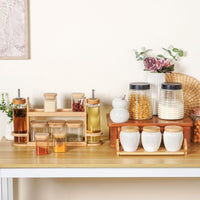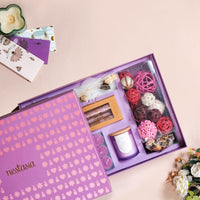As Anthelme Brillat-Savarin said, "You are what you eat."
Meal prep is not just for gym-goers or time-strapped professionals. It is one of the most practical ways to eat better, reduce stress, and stay consistent with your health goals. But healthy meal prep involves more than just bulk-cooking or packing the same salad five times over. Nutritionists rely on a few smart hacks to make sure their meals are balanced, portioned right, and genuinely good for the body. Here's how you can do the same.
Get to Know Your Macros
Macros, short for macronutrients, include protein, carbohydrates, and fats. Each uniquely affects how your body functions and feels after a meal.
Protein supports muscle repair and helps you stay full for longer. Good sources include lentils, tofu, paneer, chickpeas, quinoa, and Greek yoghurt.
Carbohydrates fuel your body and mind. Whole grains, oats, brown rice, and sweet potatoes are great choices that digest slowly and energise you.
Fats help with brain function, hormones, and vitamin absorption. Nuts, seeds, avocados, and oils like olive or mustard oil are ideal.
A simple approach is to fill your plate with 40 per cent carbs, 30 per cent protein, and 30 per cent fats. Adjust this based on how active you are or what your personal goals look like.
Danielle Gaffen(MS, RDN, LD) says, “Food is not one size-fits-all.”
In the end, the most effective approach to nutrition is one that's tailored to the individual. A successful plan should be adaptable, taking into account personal food choices as well as cultural and traditional eating habits. Eating well doesn’t have to mean sticking to a strict set of rules, there are countless ways to combine foods in a way that supports long-term health and meets nutritional requirements.
Use Portion Control Every Time
Even the healthiest meals can lose their balance if portion sizes go unchecked. A quick way to portion without a scale is to use your hands as a guide:
One palm of protein
One cupped hand of carbs
Two fists of vegetables
One thumb of healthy fats
Meal prep containers with sections can also help visually divide your meals. The goal is to eat just enough to feel satisfied and energised, not stuffed.
Dr. John Berardi helped popularise the "hand portion" method. A simple, practical way to manage portion sizes without needing a scale or counting calories. Widely trusted in the fitness and nutrition world, the approach is rooted in behaviour-based coaching.
Cook Your Ingredients in Bulk
Rather than prepping full meals that might get boring midweek, try batch-cooking your building blocks. Roast a tray of veggies, boil lentils, cook some brown rice or quinoa, and keep tofu or paneer ready to go.
This way, you can mix and match your meals each day without starting from scratch. It also gives you flexibility to switch up flavours and sauces when cravings change.
Toby Amidor, MS, RD, CDN, a respected nutritionist and cookbook author, often emphasizes the advantages of prepping staple foods like grains, proteins, and vegetables to create balanced meals throughout the week.
Shop with Clean Eating in Mind
What you buy is what you will eat. Stock up on whole foods like fruits, vegetables, legumes, whole grains, and unprocessed protein sources. Try to avoid items with long ingredient lists, added sugars, and preservatives.
A helpful tip is to stick to the outer aisles of the store, where fresh produce and dairy usually live. The inner aisles often contain more processed items.
Pre-Pack Your Snacks
Most people overeat not during meals but while snacking. Instead of munching straight from a packet, divide snacks into small reusable containers or pouches.
Good options include roasted chickpeas, spiced makhana, fruit slices, or a handful of almonds. Keeping snacks portioned and ready helps you avoid mindless eating.
Make It Tasty
Healthy food does not need to be boring. Use herbs and spices generously. Fresh coriander, mint, garlic, turmeric, ginger, cumin, and cinnamon can transform your dishes.
Instead of store-bought sauces, try simple dressings made at home using lemon juice, olive oil, vinegar, and a pinch of salt. These bring both flavour and freshness without unwanted additives.
As Maya Feller, RDN, often says, healthy eating doesn’t have to be bland. Incorporating fresh herbs and spices like coriander, turmeric, and ginger adds vibrant, natural flavours without relying on added sugars or preservatives.
Keep Healthy Food Visible
Out of sight often means out of mind. Place chopped veggies and fruits in see-through containers at eye level in your fridge. Store meal prep containers where you can see them easily.
This small shift helps you make better food choices without relying on willpower alone.
Prep for Hydration Too
Water is a vital part of your day that often gets overlooked in meal prep. Fill bottles in advance or make infused water with ingredients like mint, cucumber, lemon, or tulsi.
Having water or herbal tea handy reduces the chances of reaching for sugary drinks out of habit.
Switch Things Up Every Week
Meal prep can feel repetitive unless you bring variety into your menu. Pick one new vegetable, grain, or protein to feature each week. Try different spice blends or sauces inspired by global cuisines.
This keeps your meals interesting and your nutrient intake more diverse.
Label and Rotate Your Prepped Meals
Label containers with the date you cooked them. Try to eat the oldest items first to avoid waste. Most meals keep well in the fridge for three to four days. If you prep more than that, freeze the extras in portion-sized boxes.
Frozen meals can be reheated quickly when you're short on time, making them great backup options.
Final Thought
Meal prep can support your health goals without making your life complicated. Focus on getting your macros right, watching your portions, and building variety into each week. Keep things simple, flavourful, and visible. The more enjoyable your routine is, the easier it becomes to stick with it.
Let your meals reflect the care you want to give your body. Small steps go a long way when done consistently.


























